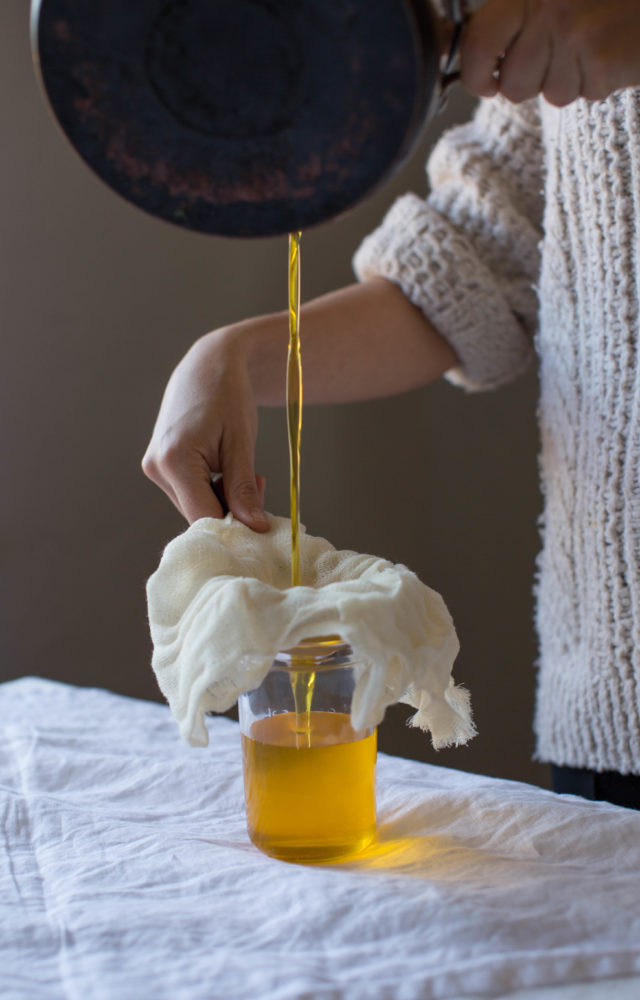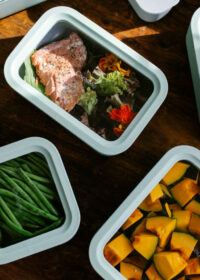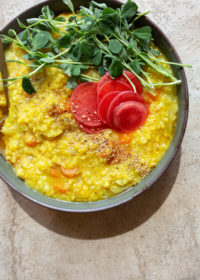Living Ayurveda: Making Ghee
 Making ghee is more an act of sacred ceremony than it is cooking a simple condiment. Though ghee itself is a diverse staple in the modern home kitchen and medicine cabinet, the process of making ghee has ancient roots. In Vedic culture, ghee has been celebrated as a symbol of nourishment and health, and touted as the food of the gods in the Vedic texts.
Making ghee is more an act of sacred ceremony than it is cooking a simple condiment. Though ghee itself is a diverse staple in the modern home kitchen and medicine cabinet, the process of making ghee has ancient roots. In Vedic culture, ghee has been celebrated as a symbol of nourishment and health, and touted as the food of the gods in the Vedic texts.
“Tongue of the gods,” “navel of immortality.”
We will proclaim the name of ghee;
We will sustain it in this sacrifice by bowing low.
These waves of ghee flow like gazelles before the hunter…
Streams of ghee caress the burning wood.
Agni, the fire, loves them and is satisfied. – Rig Veda
Bri Maya Tiwari considers ghee to be the single most ojas producing food there is. Ojas, the subtle essence of kapha, is what keeps our tissues supple and juicy. The healthy fats found in ghee nourishes our brain tissue, strengthens the nervous system, and lubricates the connective tissues. It also contains a property called butyric acid, a short-chain fatty acid that nourishes the cells of the intestinal wall and supports agni, our vital digestive fire. Ghee is used both in cooking and in healing therapies, internally and externally. It is an excellent anupana, a vehicle for transporting nutrients to the deeper tissue layers of the body, which is why you often see herbal formulas decocted in ghee. Even modern science is now studying the ancient uses of ghee and the health benefits it possesses, you can read more in these NIH studies here and here.
Ghee is used both in cooking and in healing therapies, internally and externally. It is an excellent anupana, a vehicle for transporting nutrients to the deeper tissue layers of the body, which is why you often see herbal formulas decocted in ghee. Even modern science is now studying the ancient uses of ghee and the health benefits it possesses, you can read more in these NIH studies here and here.
As a cooking oil, it can withstand much higher temperatures (up to 485F) than most oils, which often burn when overheated, creating carcinogenic effects that infuse into your food. It can be used as a 1-1 replacement for butter in recipes from baked goods to savory dishes.
There are many ways to make ghee. The traditional way is made not from butter, but from cultured buttermilk or yogurt and churned by hand – check out this this method still used in India! But for a more modern version, Divya Alter has a beautiful recipe for making ghee from buttermilk in her new book What To Eat For How You Feel. The second way, and perhaps the most accessible for the everyday cook, is by melting and clarifying butter on the stovetop. However, though the process is quite simple, the act can be one of deep intention and meditation.
Preparing ghee during certain times in the lunar cycles – specifically the waxing and full moon phase – is a way of honoring the fullness in our own lives. The moon represents soma, the Mother and her milky nourishment is considered amrita, the nectar of immortality. So when making it, chanting mantras and preparing it with a motherly attitude of love is said to enhance the nourishing qualities of the ghee.
 GHEE
GHEE
2 lbs. organic unsalted butter
In a heavy bottomed saucepan, place the butter. Turn the heat to medium to melt the butter. Once melted and solids start to bubble up to the top, reduce to low heat. Skim the foam off the top and place in a separate bowl. Stir gently to avoid burning.
A traditional way is to chant mantras while you gently stir, infusing this golden nectar with loving energy of the mantras, even playing mantras while you cook can change the energetic resonance of the food. This mantra playlist has some of my favorites, both old and new.
Continue this process of stirring and skimming until the solids are separated out completely and the bubbling has stopped, leaving a golden-hued translucent liquid. Remove from heat, allow it to cool before jarring. When ready, strain the ghee through a fine mesh strainer or several layers of cheesecloth into a clean jar. Place sealed jars in the refrigerator to set. Store at room temp in a cool, dry place or keep in the refrigerator during the warmer months. Ghee is very shelf-stable, however, it can accumulate mold in very humid, warm climates.
Makes about 2 cups
Resources
http://www.ayurvedacollege.com/articles/students/GheeBiochemicalTreatise
http://www.ancientorganics.com/ghee-a-short-consideration-from-an-ayurvedic-perspective/
https://www.ncbi.nlm.nih.gov/pmc/articles/PMC3215354/
https://www.banyanbotanicals.com/info/blog-the-banyan-insight/details/ghee-the-golden-nectar-of-ayurveda
 [wpmenucart]
[wpmenucart] Living Ayurveda: Meal Planning Tips
Living Ayurveda: Meal Planning Tips  Recipes: My Favorite Kitchari Recipe + Ume Pickled Radishes
Recipes: My Favorite Kitchari Recipe + Ume Pickled Radishes  Interview: A Behind-the-Scenes Look at the Making of A Book
Interview: A Behind-the-Scenes Look at the Making of A Book 